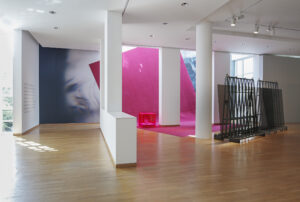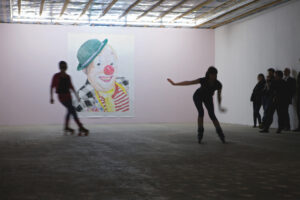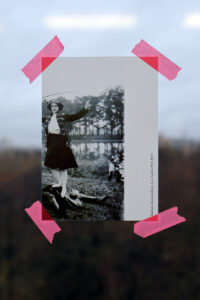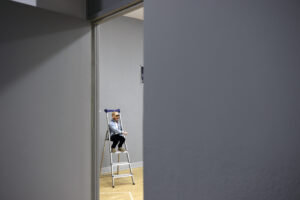Prix AWARE
© Daniel Rodriguez

Barbara Breitenfellner, Dream of an installation of a dog and various inclined surfaces. I was looking through a glass pane into a room. Brown-pink wallpaper + carpet. A strangely illuminated cube, which I saw as a photograph. Then we left the empty house.
Museum Angewandte Kunst, Frankfurt, 2015, Photo: Anja Jahn

Barbara Breitenfellner, Dream of an installation of a dog and various inclined surfaces. I was looking through a glass pane into a room. Brown-pink wallpaper + carpet. A strangely illuminated cube, which I saw as a photograph. Then we left the empty house.
Museum Angewandte Kunst, Frankfurt, 2015, Photo: Anja Jahn
For over twenty years, Barbara Breitenfellner, a Berlin-based artist of Austrian origin, has recorded her dreams. She chooses those that have to do with art, reconstructs them in space, and ultimately makes them into exhibitions.
The transcription of the dream is a many-staged process. The dream itself, often forgotten by morning, exists for the artist only as words written in a quasi-automatic fashion, in a state of semi-wakefulness. Once it has passed through this first screen of memory, the dream-statement is then transposed into the exhibition space. She titles the exhibition with it, which makes it possible to follow the trail back to what was written: external elements complete or fill in the gaps in the narration. The artist interprets her own dream, not without a sense of mischief.

Barbara Breitenfellner, Dream of a big exhibition. I had a huge and rather silly drawing (of a clown) and was very ashamed. Two girls performed on roller skates. That wasn’t good either.
Autocenter, Berlin, 2008, Photo: Thomas Bruns
In 2008, in the artist-run space Autocenter in Berlin, B. Breitenfellner presented Dream of a big exhibition. I had a huge and rather silly drawing (of a clown) and was very ashamed. Two girls performed on roller skates. That wasn’t good either. In the staging of her dream, she asked two professional dancers, headphones in ears, to do laps around and in front of a very bad drawing of a clown smiling. A disco ball and muffled disco music playing in the background made the whole thing, meticulously staged, seem a touch outdated.

Barbara Breitenfellner, “Marcel is missing” (+ description of the cat’s face). Postcard Rrose Selavy taped with Tesa on the window. 1 collage on coloured wall (cobalt blue). + contortionist with frog mask. + beginning of text “Terrorist films”. [“We have to settle this by contract,” but I’m not sure I have the right cables for the films.]
La Chambre, Aubervilliers, 2018, Photo: Gilles Berquet

Barbara Breitenfellner, “Marcel is missing” (+ description of the cat’s face). Postcard Rrose Selavy taped with Tesa on the window. 1 collage on coloured wall (cobalt blue). + contortionist with frog mask. + beginning of text “Terrorist films”. [“We have to settle this by contract,” but I’m not sure I have the right cables for the films.]
La Chambre, Aubervilliers, 2018, Photo: Barbara Breitenfellner
When I speak to B. Breitenfellner about her training in sculpture, she tells me about her classes at Glasgow School of Art at the end of the 1990s; an institution seeped in the aura of Douglas Gordon, representative of the British scene at that time: daring. There, the practice of putting on exhibitions was questioned, and one day the institution invited a magician to give a lecture, which had a profound effect on the artist. She then began to broaden her view of all the different elements which make up a show, and subsequently involved in her installations characters hailing from the world of image- and trick-making as it was in the past, through which costumed, begrimed, and cross-dressed beings paraded.
Cross-dressing, a ‘doubling’ anchored in illusionary magic shows, often recurs in the artists’ work. In 2018, in the tiny 1.3m2 room of the artist-run space of La Chambre in Aubervilliers, she invited a contortionist, dressed in a clinging green Lycra one-piece, to twist herself into every possible position. The work is entitled “Marcel is missing” (+ description of the cat’s face). Postcard Rrose Selavy taped with Tesa on the window. 1 collage on coloured wall (cobalt blue). + contortionist with frog mask. + beginning of text “Terrorist films”. [“We have to settle this by contract,” but I’m not sure I have the right cables for the films.]. Instead of just using the iconic photo of Marcel Duchamp disguised and in make-up, B. Breitenfellner uses another image from the 1920s, that of a woman placing one foot on the crushed body of a circus performer wearing a frog mask. By questioning the relations between genders in this way, the artist explores the fluctuating power dynamics of these embedded figures.

Barbara Breitenfellner, The works still have to be defined in their materiality (collage? photography? painting?). Everything is tripled. Not yet quite clear how the works are to be transferred from the virtual to the real, especially with regard to glitch and authorship. – Then a film. A snowy landscape. We walk through the snow (-storm). A girl lies down with her braid going into her back (it is digitally transformed). Then the back falls apart digitally. A liquid (blood) runs from a table and somebody else drinks it. It transforms through the body into a (liquid) drug.
Centre Photographique d’Île-de-France, Pontault-Combault, 2019, Photo: Aurélien Mole
By integrating one of her collages in the installation, B. Breitenfellner brings in this parallel practice which she works on at the same time as her dreams (the dream-statements of which are, for her, collages of writings anyway). In both cases, she works with the same sense of rhythm and of juxtaposition which creates strange, moving images. Immediate in their structural beauty, complex due to the signs strewn through them; collages are a constant ritual for the artist, who has produced over 700 of them. In 2019 this ritual culminated in a collage over 30 metres long, presented at the Centre photographique d’Île-de-France in Pontault-Combault.

Barbara Breitenfellner, Beuys was giving a several-days-long performance in 1 room. Someone else (?) stepped on 1 lying gorilla with 1 fur lying on a platform: it was a frame that was moving upwards. At the end Beuys jumped down like a winner in a circus.
HMKV, Dortmund, 2011, Photo: Hannes Woidich
Drawing only from dreams that have to do with art, B. Breitenfellner inevitably finds herself up against the masculine mythologies that dominate art’s history. Not long before she did the same with Duchamp, the artist confronted Joseph Beuys, who she transformed into a ridiculously triumphant gorilla in an exhibition at Confort moderne in Poitiers in 2011. The same is true of the ambitious project she is currently working on, where Andreas Baader is changed into a marionette with a gold-smeared face (this image has its roots in police archives, where the young man makes his first appearance –in make-up! – during a Spaßguerilla in 1967).

Barbara Breitenfellner, Andreas Baader invited me to do a show (where I was showing ceramics!?).
studio view (work-in-progress), Berlin, 2022, Photo: Barbara Breitenfellner
The dream-statement is the following: Andreas Baader invited me to do a show (where I was showing ceramics!?). The artist therefore bought a ventriloquist puppet with curmudgeonly look and daft smile, a perfect copy of Baader as exhibition curator (instead of becoming the artist he wanted to be). I see it enthroned in her studio and it startles me with its resentful presence. The power dynamics are ambiguous – the marionette speaks with its master’s voice, without completely convincing us that the master is not a slave to the whims of the puppet, who, itself, can say the unsayable.
The reconstitution of the dream is, ultimately, like the puppet itself, an analogous voice.
Kuralai Abdukhalikova
Barbara Breitenfellner was born in 1969 in Kufstein, Austria. She graduated from Glasgow School of Art with a Master of Fine Art in 1998 and subsequently moved to Berlin after brief stays in Copenhagen, London and the USA. Her work includes installations and collages, as well as silkscreen, photoengraving and art book editions. Since she became acquainted with the French scene in 2011 through a residency at Cité internationale des arts (Paris) and a personal exhibition at Le Confort Moderne (Poitiers), she has spent several months a year in the capital. She has had numerous solo shows, such as at Bétonsalon in Paris (2006), Autocenter in Berlin (2008), Hartware Medienkunstverein (HMKV) in Dortmund (2011), the Clemens Sels Museum in Neuss (2015), and the Centre Photographique d’Ile-de-France in Pontault-Combault (2019); as well as group exhibitions at Thaddaeus Ropac Gallery in Paris (2012), Museum Angewandte Kunst in Frankfurt (2015), at the Rencontres de la Photographie in Arles (2016), at the Musée d’art Moderne et Contemporain in Strasbourg (2016), at the Musée La Piscine in Roubaix (2018), and at the Deutsches Hygiene-Museum in Dresden (2021).
Translated from French by Eléonore Besse.
Tous droits réservés dans tous pays/All rights reserved for all countries.





